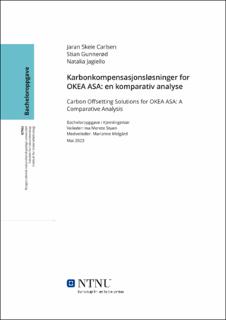| dc.description.abstract | Formålet med bacheloroppgaven var å undersøke karbonkompensasjonsløsninger, og hvordan OKEA kan benytte metodene for å kompensere for sine utslipp. I tillegg skulle det undersøkes hvordan andre olje- og gasselskap på norsk sokkel kompenserer for sine utslipp.
Ved grundig litteratursøk ble både naturbaserte og teknologibaserte løsninger undersøkt. Naturbaserte løsninger omfatter bærekraftig skogbruk, karbonlandbruk, biokull, dyphavslagring og restaurering av blå hav. Teknologibaserte løsninger omfatter Carbon Capture and Storage (CCS), Direct Air Capture and Carbon Storage (DACCS) og Bioenergy with Carbon Capture and Storage (BECCS). I tillegg er det flere mindre utviklede metoder som Indirect Ocean Capture (IOC), havalkalisering, havgjødsling, karbonlagring i ørken og økt forvitring.
På bakgrunn av teorien, ble de beste karbonkompensasjonsløsningene bestemt ved hjelp av Analytical Hierarchy Process (AHP) modellen. Løsningene ble vurdert opp mot hverandre basert på flere kriterier, som kostnad, politikk, etc. Prioriteringen av de ulike kriteriene ble fastlagt i samarbeid med Marianne Melgård.
Resultatene fra AHP viste at den beste metoden er CCS, etterfulgt av bærekraftig skogbruk og karbonlandbruk. Andre metoder som biokull, DACCS og BECCS hadde omtrentlig lik prioritet. Vår anbefaling skiller seg fra AHP-resultatene. Dette skyldes at OKEA må benytte seg av løsninger der risikoen for grønnvasking er lav. Det handler om troverdigheten til selskapet. Vår anbefaling er derfor først og fremst å benytte seg av CCS, deretter biokull og bærekraftig skogbruk. Sistnevnte kan byttes ut med restaurering av blå hav når det blir mulig. DACCS, BECCS, CO2-mineralisering og dyphavslagring har stort potensiale, og er derfor metoder som bør ha tett oppfølging. Metodene er ikke en del av vår anbefaling på grunn av høye kostnader, tidlig utviklingsstadium og foreløpig lite tilgjengelig. Andre metoder som IOC, havgjødsling, økt forvitring og havalkalisering, ble forkastet. Dette skyldes at metodene er i et tidlig utviklingsstadium, har høye kostnader og politiske utfordringer. | |
| dc.description.abstract | The aim of the bachelor’s thesis was to investigate carbon offset solutions, and how OKEA can utilize these methods to offset their emissions. Additionally, the offsetting practices of other oil and gas companies on the Norwegian continental shelf were examined.
Through a comprehensive literature review, both nature-based and technology-based solutions were explored. Nature-based solutions include sustainable forestry, carbon farming, biochar, deep ocean storage and blue ocean restoration. Technology-based solutions include Carbon Capture and Storage (CCS), Direct Air Capture with Carbon Storage (DACCS), and Bioenergy with Carbon Capture and Storage (BECCS). Furthermore, there are several less-developed methods such as Indirect Ocean Capture (IOC), ocean alkalinization, ocean fertilization, carbon storage in deserts, and enhanced weathering.
Based on the theory, the best carbon offset solutions were determined using the Analytical Hierarchy Process (AHP) model. The solutions were evaluated against each other based on various criteria, such as cost, policy, etc. The prioritization of the different criteria was determined in collaboration with Marianne Melgård.
The results from AHP suggested that the best method is CCS, followed by sustainable forestry and carbon farming. Other methods such as biochar, DACCS, and BECCS were approximately equal ranked. However, our recommendation differed from the AHP results. This is because OKEA needs to utilize solutions with low risks of greenwashing to create credibility for the company. Therefore, our recommendation is primarily to employ CCS, followed by biochar and sustainable forestry. The latter can be replaced with blue ocean restoration when possible. DACCS, BECCS, CO2 mineralization and deep ocean storage are methods that should be closely monitored due to their high potential. However, due to their significant costs, low developmental stage, and limited availability, these methods are not part of our recommendation. Other methods such as IOC, ocean fertilization, enhanced weathering, and ocean alkalinization, were rejected. This is due to their low developmental stage, high costs, and political challenges. | |
